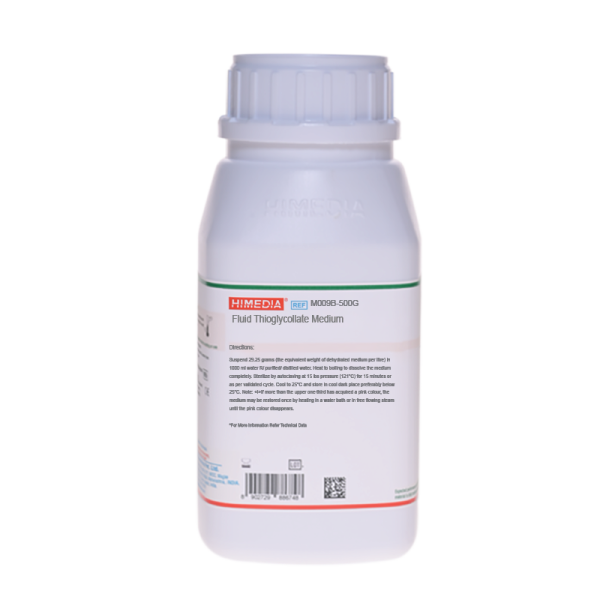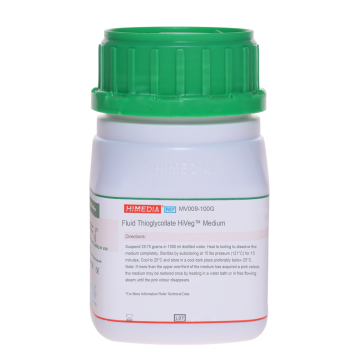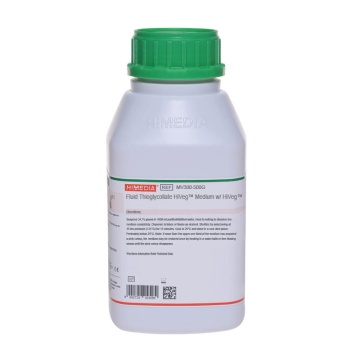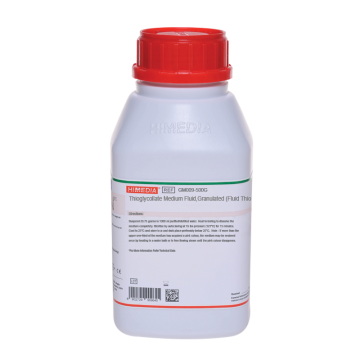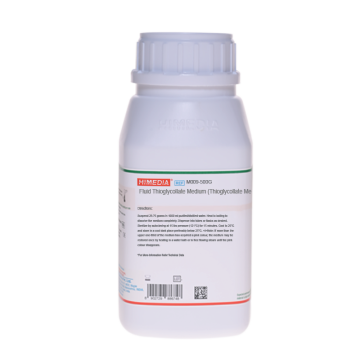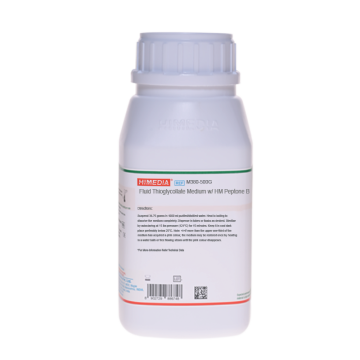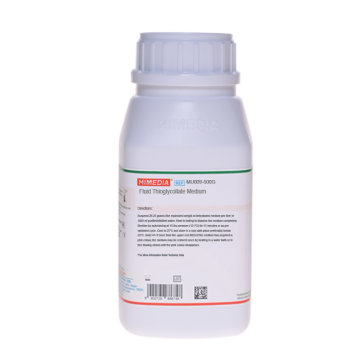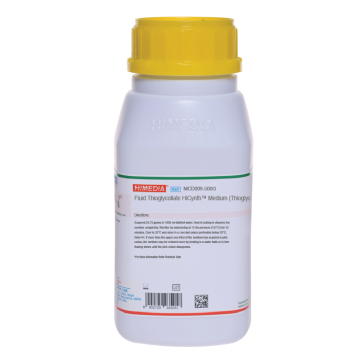 Your enquiry has been submitted
Your enquiry has been submitted
Fluid Thioglycollate Medium
Intended use
Fluid Thioglycollate Medium is used for sterility testing of biologicals and for cultivation of aerobes, anaerobes and microaerophiles as per British Pharmacopoeia.
Composition**
| Ingredients | Gms/Litre |
|---|---|
| Tryptone# | 15.000 |
| Yeast extract | 5.000 |
| Glucose monohydrate | 5.500 |
| Sodium chloride | 2.500 |
| L-Cystine | 0.500 |
| Sodium thioglycollate | 0.500 |
| Resazurin sodium | 0.001 |
| Agar | 0.750 |
| pH after sterilization (at 25°C) | 7.1±0.2 |
**Formula adjusted, standardized to suit performance parameters
# - Equivalent to Pancreatic digest of casein
Directions
Suspend 29.25 grams (the equivalent weight of dehydrated medium per litre) in 1000 ml Water R/purified/distilled water. Heat to boiling to dissolve the medium completely. Sterilize by autoclaving at 15 lbs pressure (121°C) for 15 minutes. Cool to 25°C and store in a cool dark place preferably below 25°C.
Note: If more than the upper one-third of the medium has acquired a pink-purple colour, the medium may be restored once by heating in a water bath or in free flowing steam until the pink-purple colour disappears.
Principle And Interpretation
Brewer (1) formulated Fluid Thioglycollate Medium for rapid cultivation of aerobes as well as anaerobes including microaerophiles by adding a reducing agent and small amount of agar. The British Pharmacopoeia (2) USP (10), EP (3) and AOAC (11) have recommended the media for sterility testing of antibiotics, biologicals and foods and for determining the phenol coefficient and sporicidal effect of disinfectants. However, it is intended for the examination of clear liquid or water-soluble materials.
Tryptone and yeast extract serves as a source of nitrogen, carbon, long chain amino acids. vitamins and other essential growth nutrients. Glucose monohydrate is the fermentable carbohydrate and energy source. L-cystine is the amino acid necessary for bacterial multiplication. Sodium thioglycollate and L-cystine act as a reducing agent lowering the oxidation-reduction potential by removal of oxygen. This condition helps to prevent the accumulation of peroxides which is toxic in nature. The SH group of cystine also neutralizes the antibacterial effect of mercurial preservatives and other heavy metal compounds which exert a bacteriostatic effect in the materials under examination. Any increase in the oxygen content is indicated by a colour change of redox indicator, resazurin to red (7,8,9). The small amount of agar helps in maintaining low redox potential for stabilizing the medium (6).
In sterility checking, when the sample contains preservatives, it is recommended to dilute the sample with this broth to reduce the toxicity and enhance the growth of contaminants, if any.
Type of specimen
Pharmaceutical samples for sterility testing
Specimen Collection and Handling:
For pharmaceutical samples, follow appropriate techniques for sample collection, processing as per guidelines (2) After use, contaminated materials must be sterilized by autoclaving before discarding.
Warning and Precautions
Read the label before opening the container. Wear protective gloves/protective clothing/eye protection/face protection. Follow good microbiological lab practices while handling specimens and culture. Standard precautions as per established guidelines should be followed while handling specimens. Safety guidelines may be referred in individual safety data sheets.
Limitations :
- It is intended for the examination of clear liquid or water-soluble materials.
Performance and Evaluation
Performance of the medium is expected when used as per the direction on the label within the expiry period when stored at recommended temperature.
Quality Control
Appearance Cream to yellow homogeneous free flowing powder
Colour and Clarity of prepared medium Light straw coloured, clear to slightly opalescent solution with upper 10% or less medium pink-purple on standing.
Reaction After sterilization, reaction of 2.92% w/v aqueous solution. pH: 7.1±0.2
pH 6.90-7.30
Growth Promotion Test As per British Pharmacopoeia
Growth promoting properties Clearly visible growth of microorganism comparable to that previously obtained with previously tested and approved lot of medium occurs at the specified temperature for not more than the shortest period of time specified inoculating <=100 cfu (at 30-35°C for <=3 days.
Stability test Light yellow coloured clear solution without any precipitation sedimentation at room temperature for 7 days
Cultural Response Cultural characteristics observed after an incubation at 30-35°C for not more than 3 days.
| Organism | Inoculum (CFU) | Growth |
|---|---|---|
| Clostridium sporogenes ATCC 19404 (00008*) | 50-100 | luxuriant |
| Clostridium sporogenes ATCC 11437 | 50-100 | luxuriant |
| Clostridium perfringens ATCC 13124 (00007*) | 50-100 | luxuriant |
| Bacteroides fragilis ATCC 23745 | 50-100 | luxuriant |
| Bacteroides vulgatus ATCC 8482 | 50-100 | luxuriant |
| Staphylococcus aureus subsp. aureus ATCC 25923 (00034*) | 50-100 | luxuriant |
| Staphylococcus aureus subsp. aureus ATCC 6538 (00032*) | 50-100 | luxuriant |
| Pseudomonas aeruginosa ATCC 27853 (00025*) | 50-100 | luxuriant |
| Pseudomonas aeruginosa ATCC 9027 (00026*) | 50-100 | luxuriant |
| Micrococcus luteus ATCC 9341 | 50-100 | luxuriant |
| Streptococcus pneumoniae ATCC 6305 | 50-100 | luxuriant |
| Escherichia coli ATCC 25922 (00013*) | 50-100 | luxuriant |
| Escherichia coli ATCC 8739 (00012*) | 50-100 | luxuriant |
| Escherichia coli NCTC 9002 | 50-100 | luxuriant |
| Salmonella Typhimurium ATCC 14028 (00031*) | 50-100 | luxuriant |
| Salmonella Abony NCTC 6017 (00029*) | 50-100 | luxuriant |
| Bacillus subtilis subsp. spizizenii ATCC 6633 (00003*) | 50-100 | luxuriant |
Key: * Corresponding WDCM numbers.
Storage and Shelf Life
Store between 10-30°C in a tightly closed container and the prepared medium at 15-25°C. Use before expiry date on the label. On opening, product should be properly stored dry, after tightly capping the bottle in order to prevent lump formation due to the hygroscopic nature of the product. Improper storage of the product may lead to lump formation. Store in dry ventilated area protected from extremes of temperature and sources of ignition. Seal the container tightly after use. Product performance is best if used within stated expiry period.
Disposal
User must ensure safe disposal by autoclaving and/or incineration of used or unusable preparations of this product. Follow established laboratory procedures in disposing of infectious materials and material that comes into contact with sample must be decontaminated and disposed of in accordance with current laboratory techniques (4,5).
Reference
- Brewer, 1940, J. Am. Med. Assoc., 115:598.
- British Pharmacopoeia, 2020, The Stationery office British Pharmacopoeia
- European Pharmacopoeia, 2020, European Dept. for the quality of Medicines.
- Isenberg, H.D. Clinical Microbiology Procedures Handbook 2nd Edition.
- Jorgensen, J.H., Pfaller, M.A., Carroll, K.C., Funke, G., Landry, M.L., Richter, S.S and Warnock., D.W. (2015) Manual of Clinical Microbiology, 11th Edition. Vol. 1.
- MacFaddin J.F., 1985, Media for Isolation-Cultivation-Identification-Maintenance of Medical Bacteria, Vol. 1, Williams and Wilkins, Baltimore.
- Marshall, Gunnison and Luxen, 1940, Proc. Soc. Exp. Biol. Med., 43:672.
- Nungester, Hood and Warren, 1943, Proc. Soc. Exp. Biol. Med., 52:287.
- Portwood, 1944, J. Bact., 48:255.
- The United States Pharmacopoeia, 2019, The United States Pharmacopoeial Convention, Rockville, MD.
- Williams H., (Ed.), 2005, Official Methods of Analysis of the Association of Official Analytical Chemists, 19th Ed., AOAC, Washington, D.C
| Product Name | Fluid Thioglycollate Medium |
|---|---|
| SKU | M009B |
| Product Type | Regular |
| Physical Form | Powder |
| Origin | Animal |
| Packaging type | HDPE |
| References | 1.Brewer, 1940, J. Am. Med. Assoc., 115:598. 2.The United States Pharmacopoeia, 2018, The United States Pharmacopoeial Convention, Rockville, MD. 3.British Pharmacopoeia, 2016, The Stationery office British Pharmacopoeia4.European Pharmacopoeia, 2017, European Dept. for the quality of Medicines. 5.Williams H., (Ed.), 2005, Official Methods of Analysis of the Association of Official Analytical Chemists, 19th Ed., AOAC,Washington, D.C 6.Marshall, Gunnison and Luxen, 1940, Proc. Soc. Exp. Biol. Med., 43:672. 7.Nungester, Hood and Warren, 1943, Proc. Soc. Exp. Biol. Med., 52:287. 8.Portwood, 1944, J. Bact., 48:255. 9.MacFaddin J.F., 1985, Media for Isolation-Cultivation-Identification-Maintenance of Medical Bacteria, Vol. 1, Williamsand Wilkins, Baltimore. 10.Federal Register, 1992, Fed. Regist., 21:640.0.. 11. Quastel and Stephenson, 1926, J.Biochem., 20:1.. 12.Isenberg, H.D. Clinical Microbiology Procedures Handb0ook. 2nd Edition.13Jorgensen,J.H., Pfaller , M.A., Carroll, K.C., Funke, G., Landry, M.L., Richter, S.S and Warnock., D.W. (2015)Manual of Clinical Microbiology, 11th Edition. Vol. 1. |
| Customized Product Available | No |



